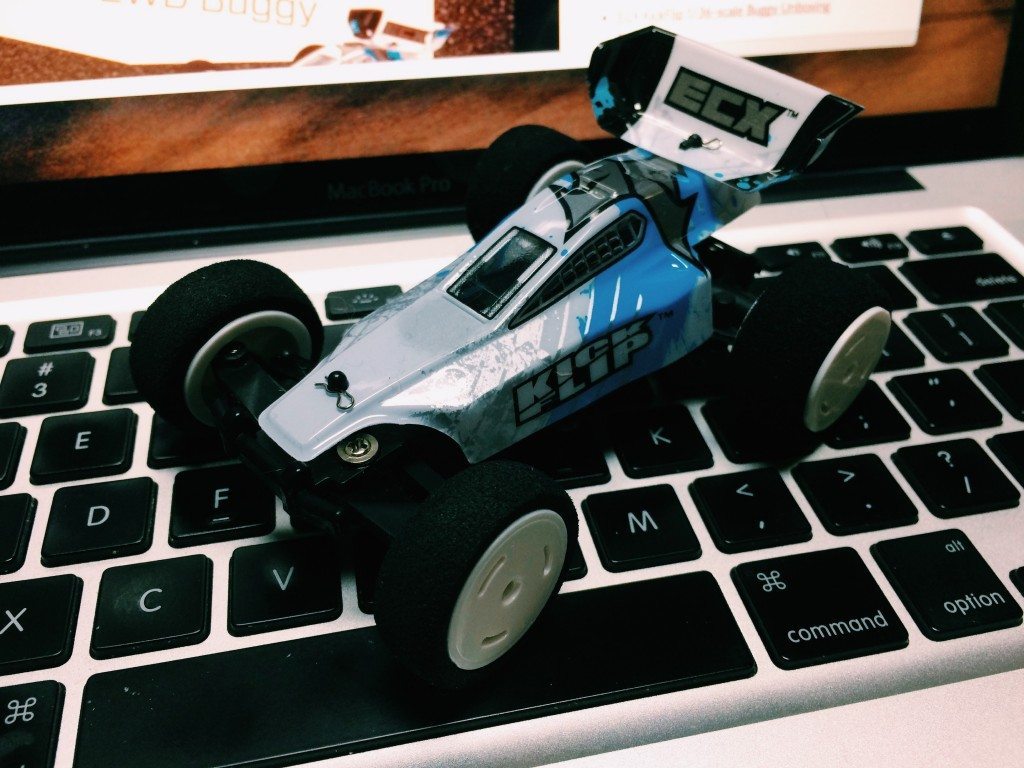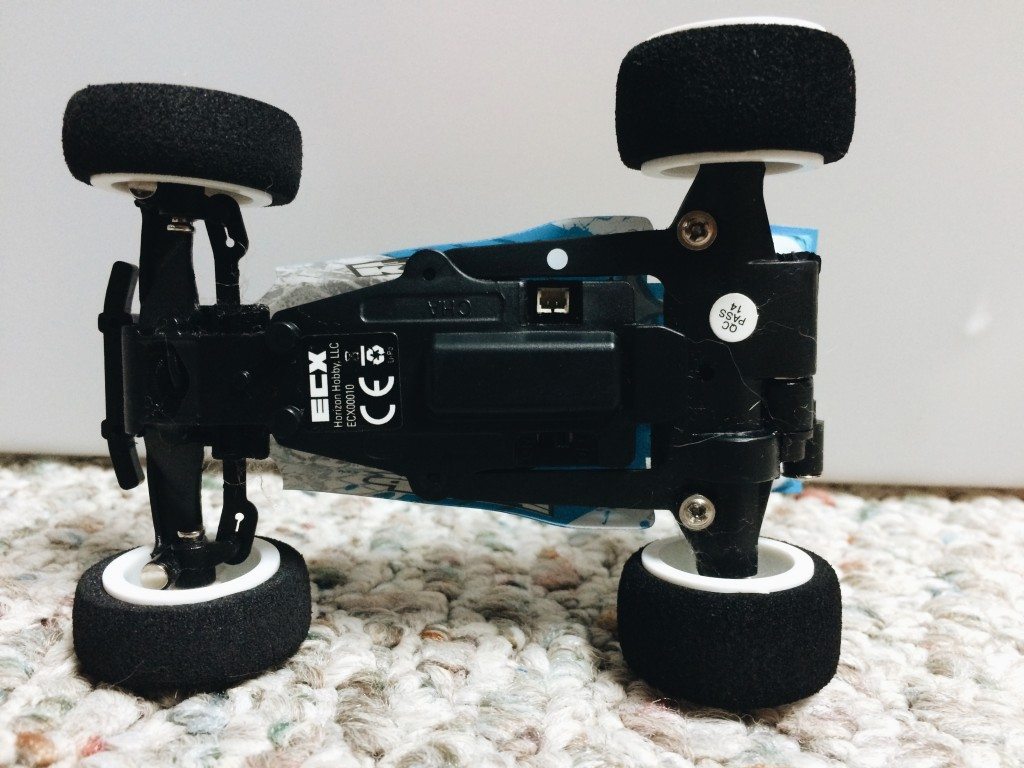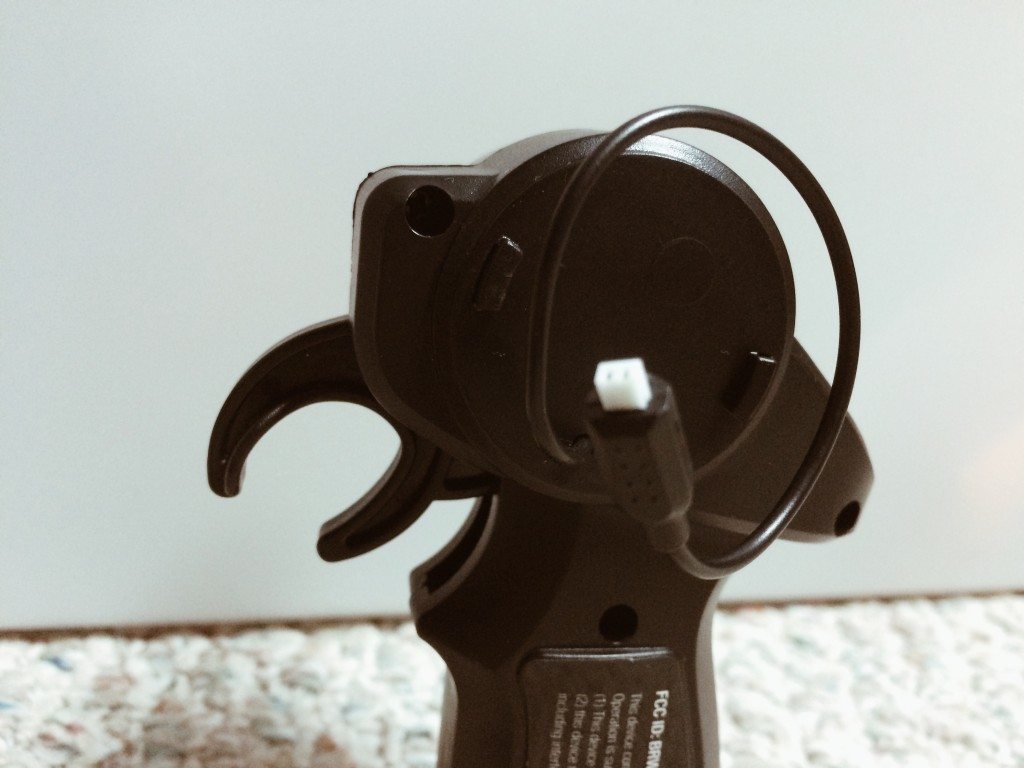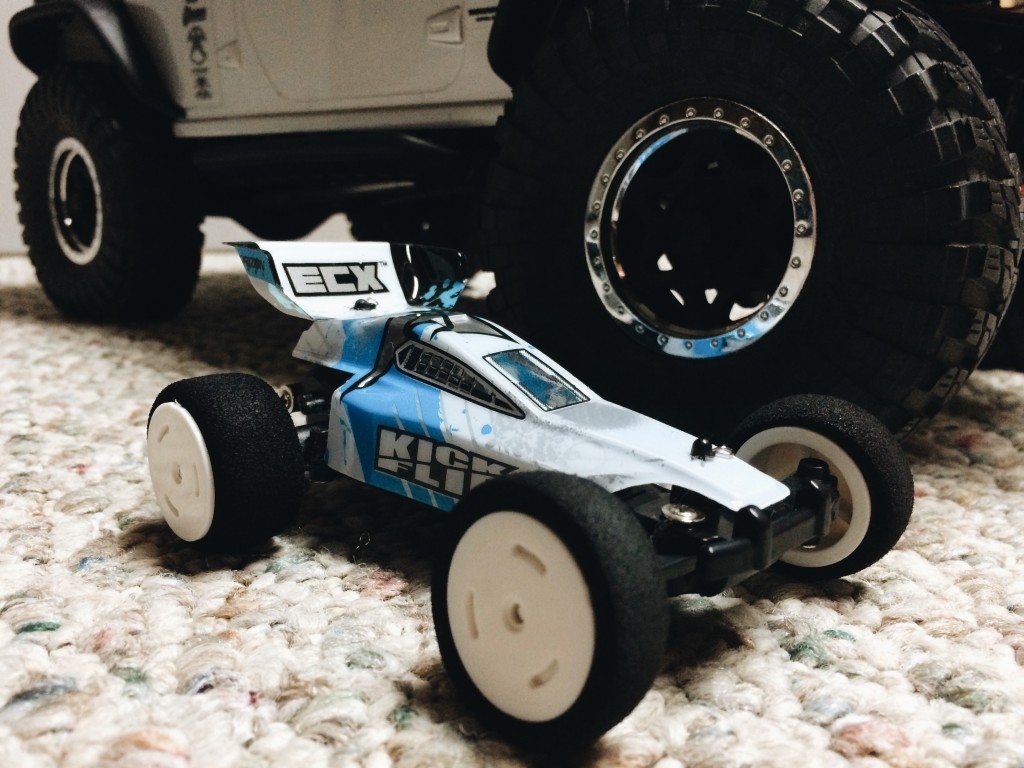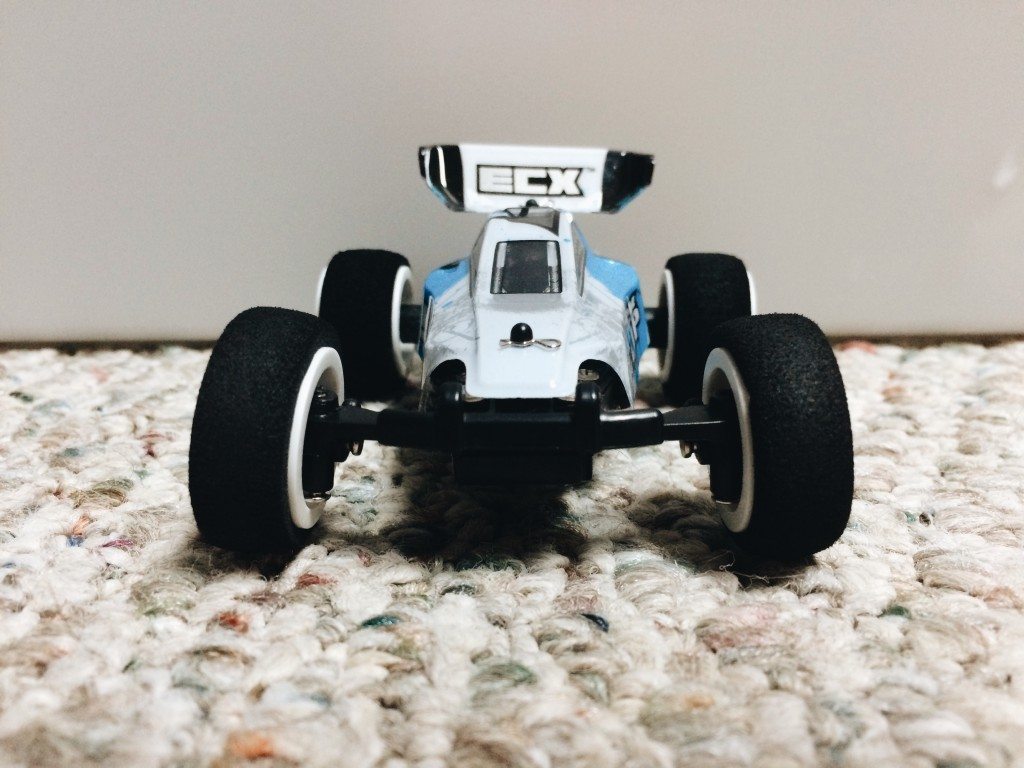A Pint-sized Powerhouse: A review of the ECX KickFlip

By: Tim Gluth
I have a confession to make. At one time, I was under the impression that the smaller the R/C car was, the less fun it would be. This thinking was based on a childhood of toy-grade vehicles that ran on four AA batteries and weak motors. They were fun, yes, but as you get older, your expectations change. Sadly, these memories were burned into my mind and came back to the surface when I went to make my first hobby-grade R/C purchase in 2012.
Fast forward a few years and I have come full-circle. Not only do I own (a few) smaller-scale R/C cars, but I love them. Let me say that again. I LOVE them. A lot. Not only are they the perfect little machine to take out when you’re bored out of your skull and need a little break from reality, but…well, I can’t really sell it more than that. They are built for fun and they deliver.
Back in September, ECX announced two new 1/36 scale RTR models, the KickFlip and the BeatBox. Aimed at indoor driving (given the small size, foam tires, and overall basic chassis setup, this is a great option for a second, third, or fourth radio-controlled car to add to your lineup.
The KickFlip and with it's bro the BeatBox, are priced at $35.99. That low cost made this one of the fastest, knee-jerk purchases that I've ever made (at least when it comes to the R/C car hobby). Before you could say “small-scale”, I had pre-ordered one of these two models, the KickFlip (buggy) and anxiously awaited it’s arrival. Given the size of these two vehicles, I was more than a little skeptical as to how they might perform, along with a variety of questions around run-time and overall enjoyment. My order arrived last week and since then I’ve been able to get some very clear answers to those questions.
The nitty-gritty.
- Make - ECX
- Model - KickFlip
- Scale - 1/36
- Body type - Buggy
- Electric or nitro - Electric
- Motor type - brushed
- Price (as tested) - $35.99
First impressions.
After performing an unboxing feature, I gave everything that came with the setup. I wasn’t expecting there the be too many items inside, and I was on-the-money with that thought. The KickFlip (and it’s sibling, the BeatBox) include the vehicle, the transmitter/remote, four AAA batteries, and some documentation (in the form of a manual and catalog). That’s it. Seeing as how this is an ultra-portable R/C vehicle, you don’t really need much more than that.
As I mentioned in the unboxing video, I was a little thrown off by the lack of a dedicated charger and cables but quickly realized that the charger and the remote are one in the same. This helps cut down on bulk and makes the overall portability of this machine that much greater. In the end, you’re left with two items to throw into your bag and take with you.
Charge!
Getting a new R/C vehicle is like riding a roller coaster. There’s the high of the impending purchase, and the low of actually paying for the machine. Then you get it home and are back on a high again as you open up the box and patiently (or furiously) remove the components. You’re then met with the harsh reality that this vehicle won’t go unless it has “juice” and bam, you’re met with another drop in excitement.
After pulling everything out of the box, I popped in the batteries and hooked the remote up to the KickFlip via the charging cable, switched the transmitter to “charge” and went about my morning. After 15-20 minutes, I glanced at the indicator light and did a double-take. It was off. Off meant charged. The car was charged! Time. To. Play.
Gnireets (that’s “Steering”…backwards).
I’ll admit that I did glance at the manual before powering the KickFlip on for the first time. It might have been a very quick glance, but I turned the pages and saw some words printed on said pages. That qualifies as reading, right? One item that I must have glanced over was the steering setup. Whoops.
On every radio-controlled vehicle that I’ve owned or driven (that uses a “pistol-style” transmitter), the steering has been set up like this:
- Turn the steering knob forward, the vehicle turns to the right.
- Turn the steering knob backward, the vehicle turns to the left.
The KickFlip and BeatBox are set up with these directions switched and there’s no way that you can change this. Trust me, I‘ve looked. While you can adjust steering trim using a dial on the vehicle itself and can adjust the throttle trim on the remote, you aren’t able to adjust the steering direction.
What that leaves you with is a bit of confusion and a little extra effort when it comes to driving. To be honest, the is the biggest issue that I have with this vehicle. For the little amount of money that this model costs, there seems to be the need for a little too much thought that needs to be put into what direction you’re going to turn, especially if you’ve built up years of muscle memory doing things a certain way. It isn’t a deal-breaker, but it takes a little getting used to.
UPDATE - 12/15/14: After contacting ECX regarding the steering configuration, they informed me that the "backwards" setup was not correct and my KickFlip did indeed have an issue. So you can rest easy, knowing that the steering controls should behave similarly to most R/C vehicles.
Aside from the directional aspect, the lack of proportional steering seems to have other folks taking a pass on picking up the KickFlip. In testing the handling and performance on a variety of indoor surfaces, I’ve found that right-hand turns are much more sharp and tight (even too tight in some cases) where the left-handed turns are very wide and need a little more preparation. If this was a performance-bred, racing buggy that I was talking about, I’d say keep your wallet in your pocket. That said, let’s not lose sight of what this machine really is; a sub-$40, 1/36-scale buggy that’s meant for fun. With that said, let’s move on.
Get up and go.
Looking back at what has surprised me about the KickFlip so far, I’d have to put the overall speed of this machine near or at the top of my list. In my own driving and having my "test crew” (three boys) give it a shakedown, I’ve noticed the KickFlip do things that I didn’t think it would ever do. The foam tires give it grip, depending on what surface you’re driving on, but if you “punch the throttle” you’ll find yourself doing donuts until you ease off and let it gain traction. It’s a great machine for jumping off of ramps and other obstacles and has pulled a few (short-lived) wheelies as it has ripped from one side of our basement to the other. The power and performance have far-exceeded what I thought this vehicle would be capable of.
Don't expect perfection.
One of the most-important items I've reminded myself of with this, and any other radio-controlled vehicle I purchase is, these machines aren’t perfect. There will be little things that strike us as odd and might throw us for a bit of a loop when driving them or building them, but that’s to be expected.
After the steering discovery, I was about to write this off as a bad investment, but the more I played around with it, the more I enjoyed it. What really sold me on it though, was witnessing my kids use it to jump off of things and just have a great time with it. That’s what it’s all about, after all and that’s what really sold me on the KickFlip.
The verdict:
The good.
- Easy on your wallet. At under $40, you won’t feel the pinch of this R/C car purchase.
- Fast charging times mean you’ll be ready to roll in next-to-no-time.
- Speed exceeds expectations.
- Pure fun. Simple as that, this machine is meant for a great time.
The not-so-good.
- Steering
both the directional controls and theperformance isn’t the strongest aspects of the KickFlip. - Foam tires and more power than this machine knows what to do with aren’t the best combination when you’re on a slick surface like a wood floor.
The bottom line.
While you’ll find other vehicles out there that may be less expensive or have smoother performance and handling, you’ll be hard-pressed to find one that nails all of these things in one package. Along with the new 1/36-scale vehicles from ECX, HPI has announced their own small-scale buggy; the Q32 Baja. Aside from the different scale, the price of HPI's model is almost double what you'll spend with the ECX models. That said there are some additional items and performance features with the Q32 that you won't find in the KickFlip or BeatBox (proportional steering and an included ramp are the two biggest items).
The KickFlip isn’t a performance monster and it isn’t meant to be. The more you drive it, the less the steering setup becomes noticeable and you become lost in the amount of fun that you’re having (or watching others have). As small-scale, low-cost R/C cars go, this is a great option if you’re looking to add a vehicle to your lineup, or give the gift of fun to someone special. And with a price of $35.99, you won't break the bank in the process.
View our KickFlip Photo Gallery
